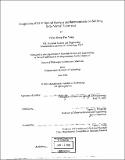| dc.contributor.advisor | Eugene A. Fitzgerald. | en_US |
| dc.contributor.author | Yang, Vicky Kung-Fan, 1975- | en_US |
| dc.contributor.other | Massachusetts Institute of Technology. Dept. of Materials Science and Engineering. | en_US |
| dc.date.accessioned | 2005-08-23T20:15:04Z | |
| dc.date.available | 2005-08-23T20:15:04Z | |
| dc.date.copyright | 2002 | en_US |
| dc.date.issued | 2002 | en_US |
| dc.identifier.uri | http://hdl.handle.net/1721.1/8446 | |
| dc.description | Thesis (Ph.D.)--Massachusetts Institute of Technology, Dept. of Materials Science and Engineering, 2002. | en_US |
| dc.description | Includes bibliographical references (p. 150-160). | en_US |
| dc.description.abstract | Because of the limitations to the functionality that Si can provide, integration of light emitting materials such as GaAs and other III-V materials provides the promise for the combination of electrical and optical devices onto a Si platform. Monolithic integration, compare to hybrid integration, is the more cost effective and reliable way to combine these dissimilar materials. However, materials compatibility issues such as lattice mismatch, polar-on-non-polar epitaxy, and thermal mismatch make the direct growth of high quality GaAs-based material on Si difficult. However, with the use of SiGe virtual substrates, Si substrates that have the Ge lattice constant, this goal can be achieved since Ge and GaAs have a small lattice mismatch of only 0.07%. High quality GaAs on Si having a threading dislocation density lower than 3x 106 cm'2 on offcut SiGe virtual substrates has been demonstrated. While utilizing SiGe virtual substrate technology to enable high quality GaAs on Si, we have studied the crack formation in GaAs layers on SiGe resulting from the thermal mismatch between the film and the substrate. GaAs has a thermal expansion coefficient of 5.8x10-6 /ʻC while the value for Si and the SiGe substrate is 2.6x10-6 /C. The thermal expansion coefficient of the SiGe virtual substrate is mainly dictated by the underlying Si substrate. As a result of the thermal mismatch, crack arrays can form in GaAs layers grown over a critical thickness after a temperature change. These cracks can act as electrical shorting paths and can also limit the usable area for device fabrication, and therefore need to be eliminated. | en_US |
| dc.description.abstract | (cont.) We have reported the experimental and calculated critical cracking thickness of GaAs on Si and SiGe in this work and have discussed possible strategies in the control of crack formation. We have also studied the luminescent characteristics of Ino.2Gao.8As quantum wells grown on the SiGe virtual substrates and other substrates such as GaAs, Si, and Ge. The luminescent intensities of InGaAs quantum wells on SiGe approach that of ones grown on GaAs substrates and out performs structures on Si and Ge substrates, an unexpected advantage for InGaAs quantum well integration on SiGe. In this work, we have also reported the first working optical interconnect on Si using SiGe virtual substrate technology. This relatively simple device structure proves the feasibility of monolithically integrated optical circuit architectures on the Si microelectronic platform. The performance of various optical interconnect structures is analyzed, and an alternative waveguide structure is proposed. | en_US |
| dc.description.statementofresponsibility | by Vicky Kung-Fan Yang. | en_US |
| dc.format.extent | 160 p. | en_US |
| dc.format.extent | 14074873 bytes | |
| dc.format.extent | 14074623 bytes | |
| dc.format.mimetype | application/pdf | |
| dc.format.mimetype | application/pdf | |
| dc.language.iso | eng | en_US |
| dc.publisher | Massachusetts Institute of Technology | en_US |
| dc.rights | M.I.T. theses are protected by copyright. They may be viewed from this source for any purpose, but reproduction or distribution in any format is prohibited without written permission. See provided URL for inquiries about permission. | en_US |
| dc.rights.uri | http://dspace.mit.edu/handle/1721.1/7582 | |
| dc.subject | Materials Science and Engineering. | en_US |
| dc.title | Integration of III-V optical devices and interconnects on Si using SiGe virtual substrates | en_US |
| dc.type | Thesis | en_US |
| dc.description.degree | Ph.D. | en_US |
| dc.contributor.department | Massachusetts Institute of Technology. Department of Materials Science and Engineering | |
| dc.identifier.oclc | 50659390 | en_US |
